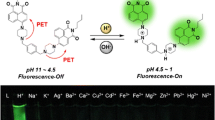Abstract
A novel switch-on fluorescent receptor for bromide was demonstrated and its binding ability toward anions was investigated by fluorescence spectroscopes and 1H NMR titration experiments. Addition of Br− to a DMSO solution of N,N-di-p-bromophenyl-1,10-phenanthroline-2,9-diamide (1) resulted in an enhancement in fluorescence intensity at 377 nm and 396 nm. Two signaling transduction mechanisms were exploited to rationalize quenching and enhancement of the fluorescence emission: inhibition of a photo-induced electronic transfer mechanism (PET) and anion-induced increase of the rigidity of the host molecule.







Similar content being viewed by others
References
Kruppa, M., König, B.: Reversible coordinative bonds in molecular recognition. Chem. Rev. 106, 3520–3560 (2006)
Shao, J., Lin, H., Yu, M., Cai, Z.Sh., Lin, H.K.: Study on acetate ion recognition and sensing in aqueous media using a novel and simple colorimetric sensor and its analytical application. Talanta. 75, 551–555 (2008)
Shao, J., Lin, H., Shang, X.F., Chen, H.M., Lin, H.K.: A novel neutral receptor for selective recognition of H2PO −4 . J. Incl. Phenom. Macrocycl. Chem. 59, 371–375 (2007)
Shao, J., Lin, H., Lin, H.K.: A simple and efficient colorimetric anion receptor for H2PO −4 . Spectrochim. Acta Part A. doi: 10.1016/j.saa.2007.08.018(in press)
Grases, F., March, J.G.: Determination of phosphate based on inhibition of crystal growth of calcite. Anal. Chim. Acta 229, 249–254 (1990)
Maeda, H., Ito, Y.: BF2 complex of fluorinated dipyrrolyldiketone: a new class of efficient receptor for acetate anions. Inorg. Chem. 46, 8205–8210 (2006)
Beer, P.D., Szemes, F., Balzani, V., Salà, C.M., Drew, M.G.B., Dent, S.W., Maestri, M.: Anion selective recognition and sensing by novel macrocyclic transition metal receptor systems. 1H NMR, electrochemical, and photophysical investigations. J. Am. Chem. Soc. 119, 11864–1175 (1997)
Amendola, V., Bastianello, E., Fabbrizzi, L., Mangano, C., Pallavicini, P., Perotti, A., Lanfredi, A.M., Ugozzoli, F.: Halide-ion encapsulation by a flexible dicopper(ii) bis-tren cryptate. Angew. Chem. Int. Ed. 39, 2917–3920 (2000)
Beer, P.D., Gale, P.A.: Anion recognition and sensing: the state of the art and future perspectives. Angew. Chem. Int. Ed. 40, 486–516 (2001)
Liu, W.X., Jiang, Y.B.: N-Amidothiourea based PET chemosensors for anions. Org. Biomol. Chem. 5, 1771–1775 (2007)
Gunnlaugsson, T., Davis, A.P., O’Brien, J.E., Glynn, M.: Fluorescent sensing of pyrophosphate and bis-carboxylates with charge neutral PET chemosensors. Org. Lett. 4, 2449–2452 (2002)
Kang, J.M., Kim, H.S., Jang, D.O.: Fluorescent anion chemosensors using 2-aminobenzimidazole receptors. Tetrahedron Lett. 46, 6079–6082 (2005)
Han, F., Bao, Y.H., Yang, Zh.G., Fyles, T.M., Zhao, J.Zh., Peng, X.J., Fan, J.L., Wu, Y.K., Sun, Sh.G.: Simple bisthiocarbonohydrazones as sensitive, selective, colorimetric, and switch-on fluorescent chemosensors for fluoride anions. Chem. Eur. J. 13, 2880–2892 (2007)
Gunnlaugsson, T., Ali, H.D.P., Glynn, M., Kruger, P.E., Hussey, G.M., Pfeffer, F.M., Dos Santos, C.M.G., Tierney, J.: Fluorescent photoinduced electron transfer (PET) sensors for anions: from design to potential application. J. Fluoresc. 15, 287–299 (2005)
Martínez-Máñez, R., Sancenón, F.: Fluorogenic and chromogenic chemosensors and reagents for anions. Chem. Rev. 103, 4419–4476 (2003)
Gunnlaugsson, T., Kruger, P.E., Lee, T.C., Parkesh, R., Pfeffer, F.M., Hussey, G.M.: Dual responsive chemosensors for anions: the combination of fluorescent PET (Photoinduced Electron Transfer) and colorimetric chemosensors in a single molecule. Tetrahedron Lett. 44, 6575–6578 (2003)
Lin, Zh.H., Zhao, Y.G., Duan, Ch.Y., Zhang, B.G., Bai, Zh.P.: A highly selective chromo- and fluorogenic dual responding fluoride sensor: naked-eye detection of F− ion in natural water via a test paper. Dalton Trans. 3678–3684 (2006) and references therein
Lee, D.H., Im, J.H., Lee, J.H., Hong, J.I.: A new fluorescent fluoride chemosensor based on conformational restriction of a biaryl fluorophore. Tetrahedron Lett. 43, 9637–9640 (2002)
Watanabe, S., Onogawa, O., Komatsu, Y., Yoshida, K.: Luminescent metalloreceptor with a neutral bis(acylaminoimidazoline) binding site: optical sensing of anionic and neural phosphodiesters. J. Am. Chem. Soc. 120, 229–230 (1998)
Bourson, J., Pouget, J., Valeur, B.: Ion-responsive fluorescent compounds. 4. Effect of cation binding on the photophysical properties of a coumarin linked to monoaza- and diaza-crown ethers. J. Phys. Chem. 97, 4552–4556 (1993)
Singh, N., Jang, D.O.: Benzimidazole-based tripodal receptor: highly selective fluorescent chemosensor for iodide in aqueous solution. Org. Lett. 9, 1991–1994 (2007)
Acknowledgment
This project was supported by the National Natural Science Foundation of China (NO.20371028, NO.20671052).
Author information
Authors and Affiliations
Corresponding author
Rights and permissions
About this article
Cite this article
Shao, J., Qiao, YH., Lin, H. et al. A novel switch-on fluorescent receptor for bromide based on an amide group. J Incl Phenom Macrocycl Chem 62, 99–103 (2008). https://doi.org/10.1007/s10847-008-9443-3
Received:
Accepted:
Published:
Issue Date:
DOI: https://doi.org/10.1007/s10847-008-9443-3



